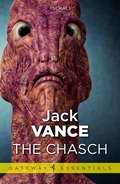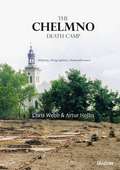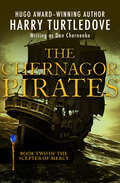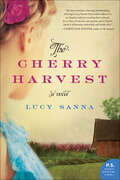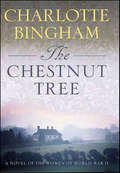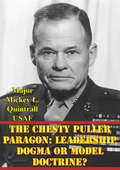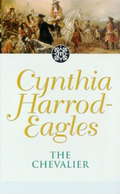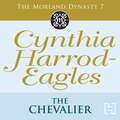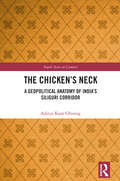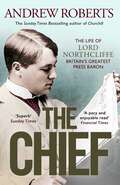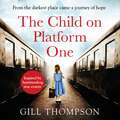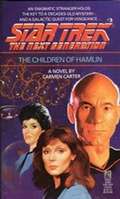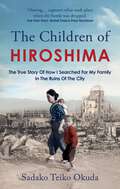- Table View
- List View
The Charming Checklist (Charming, Texas #2)
by Heatherly BellHis head made the list But his heart&’s not in it Ex-SEAL Max Del Toro persuaded his friend Ava Long to play matchmaker in exchange for posing as her boyfriend for one night. He even gave her a list of must-haves for his future wife. Except now he can&’t stop thinking about Ava—who doesn&’t check a single item on his list! Navigating his feelings seems more dangerous than any mission. Can Max abandon his plan and take a spontaneous risk for love?From Harlequin Special Edition: Believe in love. Overcome obstacles. Find happiness.Charming, TexasBook 1: Winning Mr. CharmingBook 2: The Charming Checklist
The Chasch (Gateway Essentials #183)
by Jack VanceTschai, the setting for the quartet of novels which commences with The Chasch (originally City of the Chasch), is a planet inhabited by a variety of alien species coexisting uneasily with humans - the Chasch, the Wannek, the Dirdir and the Pnume.All Jack Vance titles in the SFGateway use the author's preferred texts, as restored for the Vance Integral Edition (VIE), an extensive project masterminded by an international online community of Vance's admirers. In general, we also use the VIE titles, and have adopted the arrangement of short story collections to eliminate overlaps.
The Chase
by Clive CusslerTurn-of-the-century detective Isaac Bell pursues a blood-thirsty bank robber—and perhaps one of the world’s first sociopaths—in the first novel in the #1 New York Times-bestselling series. In 1906, the western states of America suffer a string of bank robberies by a single man who then cold-bloodedly murders any and all witnesses, and vanishes without a trace. Fed up by the depredations of “The Butcher Bandit,” the U.S. government brings in the best man it can find: a tall, lean, no-nonsense detective named Isaac Bell, who has caught thieves and killers from coast to coast. But Bell has never had a challenge like this one. From Arizona to Colorado to the streets of San Francisco during its calamitous earthquake and fire, he pursues a fiend who seems to draw pleasure from the challenge and a woman who may to hold the key to the man’s identity. As Bell begins to suspect a new term used among top psychologists, sociopath, may describe his target, the Butcher Bandit turns the chase around on him. The hunter becomes the hunted. And soon, it will take all of Bell’s skills not merely to prevail . . . but to survive. Filled with intricate plotting, Cussler’s signature dazzling set pieces, and not one but two extraordinary villains, The Chase is the master working at the height of his powers.
The Chelmno Death Camp: History, Biographies, Remembrance
by Chris Webb Artur HojanThis book is a comprehensive account of the Chelmno death camp. Chelmno was not only the first Nazi death camp, it also set a horrific example in establishing gas vans as the first mass use of poison gas to kill Jews. Chris Webb and Artur Hojan cover the construction and the development of the mass murder process as perfected by the Nazis. The story is painstakingly told from all sides, the Jewish inmates, some who survived the Holocaust, the perpetrators, the Polish Arbeitskommando, and others.A major part of this work is the Jewish Roll of Remembrance, which includes the few survivors and the Jews deported from the Reich, via the Litzmannstadt ghetto, to their deaths in the gas vans. The book is richly illustrated with historical and contemporary photographs and documents.
The Chemistry of Powder And Explosives
by Dr Tenney L. DavisThe present volume contains in one binding the whole contents of Volume I, first published in May, 1941, and the whole contents of Volume II which was published in March, 1943. The book was primarily for chemists. The writing of it was commenced in order that a textbook might be available for the use of students in the course in powder and explosives which the author gave for about twenty years (nearly every year since the first World War) to fourth-year and graduate students of chemistry and of chemical engineering at the Massachusetts Institute of Technology.[...]The aim of the book has been to describe as clearly and interestingly as possible, and as fully as seemed profitable the modes of behavior, both physical and chemical, of explosive substances, whether these modes find practical application or not. Historical material has been included where it was thought that it contributed to this end, and has not been included elsewhere or for any other reason. It is a fact that a knowledge of the history of ideas, of persons, or of things produces something of the same sympathetic understanding of them that living with them and working with them does.-Print ed.
The Chemists' War: 1914-1918
by Michael FreemantleWithin months of the start of the First World War, Germany began to run out of the raw materials it needed to make explosives. As Germany faced imminent defeat, chemists such as Fritz Haber and Carl Bosch came to the rescue with Nobel Prize winning discoveries that overcame the shortages and enabled the country to continue in the war. Similarly, Britain could not have sustained its war effort for four years had it not been for chemists like Chaim Weizmann who was later to become the first president of the State of Israel. Michael Freemantle tells the stories of these and many other chemists and explains how their work underpinned and shaped what became known as The Chemists' War. He reveals: * how chemistry contributed to the care of the sick and wounded and to the health and safety of troops; * how coal not only powered the war but was also an important source of the chemicals needed for the manufacture of explosives, dyes, medicines and antiseptics; * how Britain's production of propellants relied on the slaughter of tens of thousands of whales; * how a precious metal played a critical role in the war; * how poisonous chemicals were used as weapons of mass destruction for the first time in the history of warfare and how chemists developed gas masks for protection against these weapons; * how the British naval blockade of Germany imperilled agricultural production in the United States. The book will appeal to the general reader as well as the many scientists and historians interested in the Great War.
The Chernagor Pirates (The Scepter of Mercy #2)
by Harry TurtledoveOnly a long-lost talisman can save a besieged kingdom torn between two kings, as a malevolent god marshals his minions to attack, corrupt, and destroy Two lieges--King Lanius, who is of royal blood, and King Grus, the usurper--now share the throne of Avornis. The former wields no real power, kept impotent by the regents surrounding him. The latter mans the battle lines, determined to protect the kingdom from a fearsome, immortal god who was expelled from heaven. To the north, the city-state Chernagor is being torn asunder by a savage civil war that threatens to spill past the border at any moment. Catastrophe looms for Avornis and even two kings united may not be strong enough to save her. The kingdom's final hope lies in the recovery of the Scepter of Mercy, lost for four centuries. But the mighty talisman is in the hands of the Menteshe--barbarian nomads who are vassals of the terrible exiled god--and now that the Banished One wants to consume the entire world, they will never relinquish its power. The Scepter of Mercy, Harry Turtledove's epic fantasy trilogy, continues with The Chernagor Pirates, the second volume in an adventure that pits man against man, and man against immortal. Originally penned under the pseudonym Dan Chernenko, it is an unforgettable tale that demonstrates the unparalleled creativity and unique storytelling prowess of the Hugo Award-winning master world-builder.
The Cherry Harvest: A Novel
by Lucy SannaThe tumult of WWII visits a Wisconsin family when a German POW comes to work on their farm in this novel of love and hardship on the American home front.Wisconsin, 1944. where even the lush cherry orchards and green lakeside farms can't escape the ravages of war. With food rationed and money scarce, the Christiansen family struggles to hold on. The family's teenage daughter, Kate, raises rabbits to save money for college, while her mother, Charlotte, barters what she can to make ends meet. Charlotte's husband, Thomas, strives to keep the orchard going while their son—along with most of the other able-bodied men—is fighting overseas. With the upcoming harvest threatened by the labor shortage, strong-willed Charlotte helps persuade local authorities to allow German war prisoners from a nearby POW camp to pick the fruit. But when Thomas befriends one of the prisoners, a math teacher named Karl, and invites him to tutor Kate, both Charlotte and Kate are swept into a world where love, duty, and honor are not as clear-cut as they might have believed. Charlotte and Thomas fail to see that Kate is becoming a young woman, with dreams and temptations of her own. And when their beloved son, Ben, returns from the battlefield, wounded and bitter, the secrets they've all been keeping threaten to explode their world.
The Chesapeake Campaigns 1813-15
by Graham Turner Scott SheadsThe War of 1812 was never the most popular of conflicts on both sides of the Atlantic. Bogged down by their involvement in the Napoleonic conflict in Europe, the British largely relied on the power of the Royal Navy in the early years of the war. Part of this naval strategy was to blockade the American coastline in order to strangle American commerce and bring the new nation to its knees. Nowhere was this blockade more important than in the Chesapeake. Partly in response to the sacking of York (modern Toronto), the British decided to strike at the nation's capital, Washington, DC, and a force of Peninsular War veterans under General Robert Ross landed, defeated the Americans at the battle of Bladensburg and took Washington on August 24, 1814. Buoyed by this success, the British pressed on towards Baltimore. However, they were forced to withdraw at the battle of North Point, and a naval bombardment of Fort McHenry failed to reduce the fort and Baltimore was spared. With his intimate knowledge of the events in this theatre of war, Scott Sheads of Fort McHenry NPS brings these dramatic events of American history to life.
The Chestnut Tree: A Novel of the Women of World War II
by Charlotte BinghamBy bestselling British writer Charlotte Bingham, The Chestnut Tree is a sweeping, romantic novel about the women who stayed behind in World War II.It is the summer of 1939, and the residents of the idyllic Sussex fishing port of Bexham are preparing for war. Beautiful but shy Judy Melton, daughter of a naval hero; her determinedly feckless friend, the social butterfly Meggie Gore-Steward; seemingly demure Mathilda Eastcott, and Rusty Sykes, the tomboy daughter of the owner of the local boatyard, are all in their very individual ways determined to play an active part in the defense of their country. But knitting socks and bomb-dodging are not what they have in mind.Under the tree on the green the women of Bexham meet to look back on a landscape that has changed irrevocably, and which they have in their own ways helped to alter. None of them are the same, and yet, with the men returning from war, they are expected to slip back into their simple roles of mother, daughter, grandmother. This, more than anything perhaps, is their greatest sacrifice.Only the chestnut tree planted by Corrie at the edge of the village flourishes in the accepted manner, finally becoming the uniting symbol of all that has passed forever.
The Chesty Puller Paragon: Leadership Dogma Or Model Doctrine?
by Major Mickey L. Quintrall USAFIn this study, I examine whether or not the United States Marine Corps senior warrior-leaders should continue to use heroic-warriors from the 1942-52 era as contemporary paragons of tactical leadership. Additionally, I compare the Marine tactical leadership models between 1942-52, and their relevance within the cultivated and refocused leadership doctrine of today's Marine Corps. Then, I examine whether or not there is a gap created using an earlier era's tactical leadership example to model contemporary tactical battlefield leadership.The Marine Corps tactical leadership criteria and what the Corps expected of its commanders during World War II and the Korean War is the starting point. There was not much written leadership guidance then, but there was accepted leadership doctrine, nonetheless. Today, several United States Marines are recognized as setting the contemporary paragon for the ideal tactical battlefield leader. Among them, is World War II and Korean War Marine Lewis "Chesty" Burwell Puller. Chesty Puller not only set a courageous combat example, he trained his men hard, respected his men's fearlessness, and worked hard to build unit comradeship.Service parochialism and cultural turmoil through the Vietnam War set the stage for a rocky period in the history of the Corps, leading up to the Commandant's re-focus on a new Marine followership-leadership ethos. The Marine Corps' recent efforts to "Transform" their Marines into a new breed is an attempt to transform leadership dogma to leadership-followership doctrine. His fresh approach is thought to better inculcate the Marine culture with loyalty and commitment to the Corps, similar to what was experienced within World War II Marine Corps.The thrust of the monograph pursues the question: Does Chesty Puller provide the right contemporary leadership example, or does he perpetuate dogma?
The Chetnik Movement and the Yugoslav Resistance
by Matteo J. MilazzoOriginally published in 1975. This book fills a gap in the historical knowledge of wartime Yugoslavia. Focusing on the Chetnik movement provides a better understanding of the various ways that important segments of the population, including members of the Yugoslav officer corps and Serb civilians, perceived and responded to the occupation. The partisans' ultimate success does not conceal the fact that during the greater part of the war, several armed groups, owing at least some sort of allegiance to Mihailovic, chose very different courses of resistance. The overriding question for Milazzo is how a movement whose leadership was in no sense pro-Axis found itself progressively drawn into a hopelessly compromising set of relationships with the occupation authorities and the Quisling regime. What was it about the situation in occupied Yugoslavia and the Serb officers' response to that state of affairs that prevented them from carrying out serious anti-Axis activity or engaging in effective collaboration? The author attends to the emergence, organization, and failure of the Chetniks, the regional particularities of the movement, and Mihailovic's efforts to establish his own authority over the widely scattered non-Communist armed formations. The author also discusses the domestic opposition to Tito and the complex reality of the national and political civil war in Yugoslavia.
The Chevalier: The Morland Dynasty, Book 7 (Morland Dynasty #7)
by Cynthia Harrod-Eagles1689: the Resoration enabled the Morland family to restore their own fortune, but now the Jacobite rebellion brings another threat to their security.Annuciata Morland, fiercely loyal to the Stuart cause, follows her beloved king, James II, into exile. She leaves her gentle grandson, Matt, to oversee Morland Place in her absence. Without her wise presence, Matt finds himself in an arranged marriage to India Neville and at the mercy of a woman as heartless as she is beautiful. After a lonely and sheltered life he lurches between the exquisite pain of love and the torment of deep despair.When James III - the Chevalier - returns to claim the Stuart throne, the Morlands are reunited in one country. Death and defeat threaten them, but their loves and loyalty prove stronger than kingly ambitions...
The Chevalier: The Morland Dynasty, Book 7 (Morland Dynasty #7)
by Cynthia Harrod-Eagles1689: the Resoration enabled the Morland family to restore their own fortune, but now the Jacobite rebellion brings another threat to their security.Annuciata Morland, fiercely loyal to the Stuart cause, follows her beloved king, James II, into exile. She leaves her gentle grandson, Matt, to oversee Morland Place in her absence. Without her wise presence, Matt finds himself in an arranged marriage to India Neville and at the mercy of a woman as heartless as she is beautiful. After a lonely and sheltered life he lurches between the exquisite pain of love and the torment of deep despair.When James III - the Chevalier - returns to claim the Stuart throne, the Morlands are reunited in one country. Death and defeat threaten them, but their loves and loyalty prove stronger than kingly ambitions.
The Chickamauga Campaign: The Breakthrough, Union Collapse, and the Retreat to Chattanooga, September 20–23, 1863
by David A. PowellThe second volume in a three-volume study of this overlooked and largely misunderstood campaign of the American Civil War.According to soldier rumor, Chickamauga in Cherokee meant “River of Death.” The name lived up to that grim sobriquet in September 1863 when the Union Army of the Cumberland and Confederate Army of Tennessee waged a sprawling bloody combat along the banks of West Chickamauga Creek. This installment of Powell’s tour-de-force depicts the final day of battle, when the Confederate army attacked and broke through the Union lines, triggering a massive rout, an incredible defensive stand atop Snodgrass Hill, and a confused retreat and pursuit into Chattanooga. Powell presents all of this with clarity and precision by weaving nearly 2,000 primary accounts with his own cogent analysis. The result is a rich and deep portrait of the fighting and command relationships on a scale never before attempted or accomplished.His upcoming third volume, Analysis of a Barren Victory, will conclude the set with careful insight into the fighting and its impact on the war, Powell’s detailed research into the strengths and losses of the two armies, and an exhaustive bibliography.Powell’s magnum opus, complete with original maps, photos, and illustrations, is the culmination of many years of research and study, coupled with a complete understanding of the battlefield’s complex terrain system. For any student of the Civil War in general, or the Western Theater in particular, Powell’s trilogy is a must-read.“Extremely readable, heavily researched, and mammoth in scope, Dave Powell’s Chickamauga study will prove to be the most detailed treatment of the battle to date. Civil War buffs and historians alike will want these books on their bookshelves. where they will take their rightful place beside Tucker and Cozzens as seminal volumes on the battle.” —Timothy B. Smith, author of Champion Hill and Corinth 1862“[Powell’s] latest monograph, The Chickamauga Campaign - Glory or the Grave . . . sets the standard for Civil War battle studies. . . . No one will ever look at Chickamauga the same way again.” —Lee White, Park Ranger, Chickamauga and Chattanooga National Military Park
The Chicken's Neck: A Geopolitical Anatomy of India's Siliguri Corridor (South Asia in Context)
by Aditya Kant GhisingThis book explores the nuances of settlement, migration, development, and geopolitics in the region known as the Siliguri Corridor, located in eastern India. It assesses the security challenges emerging from neighboring countries located in the immediate vicinity of the corridor—Nepal, Bangladesh, Bhutan, and China.It analyzes the notion of the Chinese threat, or more particularly, the practicality and viability of its supposed “pincer move” to separate the Northeastern region of India by targeting the narrow Siliguri Corridor, which serves as the only physical link between the eight states and the rest of India. The book also focuses on the evolving dynamics of China’s increasing foothold in the neighborhood and its potential impact on India’s threat perception and strategy formulation with regard to the Siliguri Corridor.The volume will be of great interest to scholars and researchers of South Asian studies, China studies, international politics, and military and strategic studies.
The Chief Culprit
by Viktor Suvorov"A remarkable book. A delayed bombshell that includes very pertinent new research and discoveries Suvorov has made since 1990. He makes savvy readers of contemporary and World War II history, of a mind to reexamine the Soviet past in terms of what historians call 'present interest.' None of the 'new Russian' historians can match his masterful sweep of research and analysis."-ALBERT WEEKS, Professor Emeritus of International Relations, New York University, author of Stalin's Other War: Soviet Grand Strategy, 1939-1941In The Chief Culprit, bestselling author Victor Suvorov probes newly released Soviet documents and reevaluates existing historical material to analyze Stalin's strategic design to conquer Europe and the reasons behind his controversial support for Nazi Germany. A former Soviet army intelligence officer, the author explains that Stalin's strategy leading up to World War II grew from Lenin's belief that if World War I did not ignite the worldwide Communist revolution, then a second world war would be necessary.Suvorov debunks the theory that Stalin was duped by Hitler and that the Soviet Union was a victim of Nazi aggression. Instead, he makes the case that Stalin neither feared Hitler nor mistakenly trusted him. He maintains that after Germany occupied Poland, defeated France, and started to prepare for an invasion of Great Britain, Hitler's intelligence services detected the Soviet Union's preparations for a major war against Germany. This detection, Suvorov argues, led to Germany's preemptive war plan and the launch of an invasion of the USSR. Stalin emerges from the pages of this book as a diabolical genius consumed by visions of a worldwide Communist revolution at any cost-a leader who wooed Hitler and Germany in his own effort to conquer the world. In contradicting traditional theories about Soviet planning before the German invasion and in arguing for revised view of Stalin's real intentions, The Chief Culprit has provoked debate among historians throughout the world.
The Chief: The Life of Lord Northcliffe Britain's Greatest Press Baron
by Andrew Roberts'Superb...his pages fizz with character and colour' Dominic Sandbrook, Sunday Times 'Scholarly and very readable' Andrew Lycett, Spectator 'Energetic and hugely entertaining' A.N.Wilson, TLSThe definitive biography of Alfred Harmsworth, 1st Viscount Northcliffe, the first and greatest press magnate in history and the genius who invented modern popular journalism. The turn of the century was a period when the world was opening up in new and exciting ways – radio, telegrams, the advent of flight. With literacy and the right to vote extending across an ever-expanding populace, politics and journalism were embarking on a power struggle that continues unabated to this day. Lord Northcliffe rose to the challenges of this new world by employing cutting-edge technology, upending the outdated mores of traditional journalism and radically reshaping the very concept of &‘news&’. He was a tough and uncompromising businessman, frequently levelled with charges of megalomania, but in The Chief Andrew Roberts puts Northcliffe&’s ruthlessness in the context of a life of visionary business skill, journalistic brilliance, distinguished wartime public service and heartfelt patriotism. The man was, undoubtedly, a genius – albeit a flawed one. From a modest background, growing up on the outskirts of Dublin, by twenty-seven he presided over a magazine empire with the largest circulation in the world. By the time of his tragically early death in 1922, Northcliffe had founded the Daily Mail and Daily Mirror, and had also owned The Times and the Observer. At one point he owned two thirds of all the titles on Fleet Street. Based on exclusive access to the Harmsworth family archive, The Chief charts Lord Northcliffe&’s rise to power and his highly controversial influence in a politically critical period. His influence still resonates today both through his remarkable business innovations and in the way we consume our news and politics.
The Child On Platform One: Inspired by the children who escaped the Holocaust
by Gill ThompsonTO SAVE HER CHILD, A MOTHER MUST MAKE AN IMPOSSIBLE CHOICE.'Heartrending. Riveting. Definitely on my list of Ten Best Books of 2019' Sharon Maas, author of The Violin Maker's Daughter'The characters and their moving stories will haunt you long after you finish the last page' Shirley Dickson, author of The Orphan SistersInspired by the children who escaped the Holocaust. Perfect for readers of The Tattooist of Auschwitz by Heather Morris and My Name is Eva by Suzanne Goldring.Prague 1939. Young mother Eva has a secret from her past. When the Nazis invade, Eva knows the only way to keep her daughter Miriam safe is to send her away - even if it means never seeing her again. But when Eva is taken to a concentration camp, her secret is at risk of being exposed.In London, Pamela volunteers to help find places for the Jewish children arrived from Europe. Befriending one unclaimed little girl, Pamela brings her home. Then when her son enlists in the RAF, Pamela realises how easily her own world could come crashing down...Readers around the world adore THE CHILD ON PLATFORM ONE:'OH MY HEART! Moved me deep from within. I cannot recommend it enough' The Writing Garnet'Such a gorgeous book. I loved and believed in all the characters, and thoroughly enjoyed their stories. Incredibly researched, it felt authentic. And the ending moved me to tears *****''OMG What an incredible read. It was so emotional about a Jewish girl. I was engrossed from start to finish and would highly recommend this book *****''This book was incredible... The story is realistic and believable. Once you start reading you will not want to stop *****''An emotional, haunting book filled with secrets throughout. Excellent *****''I loved the book and the way it was written. I will be reading more novels by Gill Thompson in the future as her interweaving of events with fictional characters is remarkable *****''This was a great book! There are secrets you will not see coming, but it makes it more heartwarming *****''It's not your normal evacuee story as it's intertwined with other stories which I really enjoyed. It had me gripped. I will be looking out for more books by this author *****''This is a very good book. I recommend you read *****'
The Child On Platform One: Inspired by true events, a gripping World War Two historical novel for readers of The Tattooist of Auschwitz
by Gill ThompsonTO SAVE HER CHILD, A MOTHER MUST MAKE AN IMPOSSIBLE CHOICE.'Heartrending. Riveting. Definitely on my list of Ten Best Books of the year' Sharon Maas, author of The Violin Maker's Daughter------Prague 1939. Young mother Eva has a secret from her past. When the Nazis invade, Eva knows the only way to keep her daughter Miriam safe is to send her away - even if it means never seeing her again. But when Eva is taken to a concentration camp, her secret is at risk of being exposed.In London, Pamela volunteers to help find places for the Jewish children arrived from Europe. Befriending one unclaimed little girl, Pamela brings her home. Then when her son enlists in the RAF, Pamela realises how easily her own world could come crashing down...Inspired by the children who escaped the Holocaust. Perfect for readers of The Tattooist of Auschwitz by Heather Morris.'What an incredible read. It was so emotional about a Jewish girl. I was engrossed from start to finish and would highly recommend this book ⭐ ⭐ ⭐ ⭐ ⭐''Such a gorgeous book. I loved and believed in all the characters, and thoroughly enjoyed their stories. And the ending moved me to tears ⭐ ⭐ ⭐ ⭐ ⭐''This book was incredible... The story is realistic and believable. Once you start reading you will not want to stop ⭐ ⭐ ⭐ ⭐ ⭐''An emotional, haunting book filled with secrets throughout. Excellent ⭐ ⭐ ⭐ ⭐ ⭐''I loved the book and the way it was written. I will be reading more novels by Gill Thompson in the future as her interweaving of events with fictional characters is remarkable ⭐ ⭐ ⭐ ⭐ ⭐''This was a great book! There are secrets you will not see coming, but it makes it more heartwarming ⭐ ⭐ ⭐ ⭐ ⭐''It's not your normal evacuee story as it's intertwined with other stories which I really enjoyed. It had me gripped. I will be looking out for more books by this author ⭐ ⭐ ⭐ ⭐ ⭐''This is a very good book. I recommend you read ⭐ ⭐ ⭐ ⭐ ⭐'
The Child On Platform One: Inspired by true events, a gripping World War Two historical novel for readers of The Tattooist of Auschwitz
by Gill ThompsonTO SAVE HER CHILD, A MOTHER MUST MAKE AN IMPOSSIBLE CHOICE.'Heartrending. Riveting. Definitely on my list of Ten Best Books of the year' Sharon Maas, author of The Violin Maker's Daughter------Prague 1939. Young mother Eva has a secret from her past. When the Nazis invade, Eva knows the only way to keep her daughter Miriam safe is to send her away - even if it means never seeing her again. But when Eva is taken to a concentration camp, her secret is at risk of being exposed.In London, Pamela volunteers to help find places for the Jewish children arrived from Europe. Befriending one unclaimed little girl, Pamela brings her home. Then when her son enlists in the RAF, Pamela realises how easily her own world could come crashing down...Inspired by the children who escaped the Holocaust. Perfect for readers of The Tattooist of Auschwitz by Heather Morris.'What an incredible read. It was so emotional about a Jewish girl. I was engrossed from start to finish and would highly recommend this book ⭐ ⭐ ⭐ ⭐ ⭐''Such a gorgeous book. I loved and believed in all the characters, and thoroughly enjoyed their stories. And the ending moved me to tears ⭐ ⭐ ⭐ ⭐ ⭐''This book was incredible... The story is realistic and believable. Once you start reading you will not want to stop ⭐ ⭐ ⭐ ⭐ ⭐''An emotional, haunting book filled with secrets throughout. Excellent ⭐ ⭐ ⭐ ⭐ ⭐''I loved the book and the way it was written. I will be reading more novels by Gill Thompson in the future as her interweaving of events with fictional characters is remarkable ⭐ ⭐ ⭐ ⭐ ⭐''This was a great book! There are secrets you will not see coming, but it makes it more heartwarming ⭐ ⭐ ⭐ ⭐ ⭐''It's not your normal evacuee story as it's intertwined with other stories which I really enjoyed. It had me gripped. I will be looking out for more books by this author ⭐ ⭐ ⭐ ⭐ ⭐''This is a very good book. I recommend you read ⭐ ⭐ ⭐ ⭐ ⭐'
The Child from Nowhere (Poor House Lane Sagas)
by Freda LightfootAs the Great War looms, will the women of Kendal rise to meet the challenge?After giving birth to her daughter, Kate O’Connor finds herself back in Poor House Lane with some momentous decisions to make.Faced with the opportunity to move out of the slums, she invests her unexpected fortune in a new shoe factory to challenge Eliot Tyson’s monopoly over the workforce, regardless of whether or not he is the father of her children.But nothing is ever that simple, especially when old enemies and estranged relatives return to thwart her every scheme…The second, moving instalment in The Poor House Lane Sagas,The Child From Nowhere is a wartime saga perfect for fans of Val Wood and Katie Flynn
The Children of Hamlin (Cold Equations #3)
by Carter CarmenThe Hamlin Massacre -- every Starfleet officer knows the tale. The tiny Federation outpost of hamlin was destroyed, its entire adult population ruthlessly slaughtered, before the first defense shield could be raised. Even worse, the colony's children disappeared without a trace, abducted by the aliens who attacked with a ferocity and speed that outmatched their Starfleet pursuers. Now, fifty years later, the Choraii ships have appeared again. But this time the Federation is ready; this time the Choraii must pay for what they need. The precious metals can only be bought with the Hamlin children still living with their captors. This time, the Choraii must face Captain Jean-Luc Picard -- and the crew of the starship Enterprise...
The Children of Hiroshima: The True Story Of How I Searched For My Family In The Ruins Of The City
by Sadako Teiko OkudaThe little boy did not cry or speak. He just stood there and stared at me intensely. With great effort I stood up and tested to see if I could walk with my injured foot. When I did, he came to stand even closer to me and, without saying a word, grabbed my little finger very tightly.Sadako Teiko Okuda was living in Osaki-shimo, an island off the mainland of Japan, when the bomb hit Hiroshima on the 6th of August 1945. Even sixty kilometers from the city, it was clear something horrific had happened. There was a blinding flash and the window next to Sadako smashed, a shard of glass leaving a painful burn on her neck. Soon, news came that her niece and nephew who lived in Hiroshima were missing. There was only one thing she could do - leave the relative safety of the island and set off into the city to find them.In the seven long days that followed, Sadako roamed the ruins of the city, desperately hoping that she would catch sight of her family and in the meantime coming across dozens of other children who were alone, distraught and in pain. Carrying only water and a little medicine, she did her best to nurse the children and offer what care, compassion and tenderness she could in unimaginable circumstances. And in turn, they helped her to find hope in the very darkest of times.Told simply and powerfully in daily diary entries, The Children of Hiroshima is an extraordinary and deeply moving human story of loss, innocence and hope.
The Children of Hiroshima: The True Story Of How I Searched For My Family In The Ruins Of The City
by Sadako Teiko OkudaThe little boy did not cry or speak. He just stood there and stared at me intensely. With great effort I stood up and tested to see if I could walk with my injured foot. When I did, he came to stand even closer to me and, without saying a word, grabbed my little finger very tightly.Sadako Teiko Okuda was living in Osaki-shimo, an island off the mainland of Japan, when the bomb hit Hiroshima on the 6th of August 1945. Even sixty kilometers from the city, it was clear something horrific had happened. There was a blinding flash and the window next to Sadako smashed, a shard of glass leaving a painful burn on her neck. Soon, news came that her niece and nephew who lived in Hiroshima were missing. There was only one thing she could do - leave the relative safety of the island and set off into the city to find them.In the seven long days that followed, Sadako roamed the ruins of the city, desperately hoping that she would catch sight of her family and in the meantime coming across dozens of other children who were alone, distraught and in pain. Carrying only water and a little medicine, she did her best to nurse the children and offer what care, compassion and tenderness she could in unimaginable circumstances. And in turn, they helped her to find hope in the very darkest of times.Told simply and powerfully in daily diary entries, The Children of Hiroshima is an extraordinary and deeply moving human story of loss, innocence and hope.

